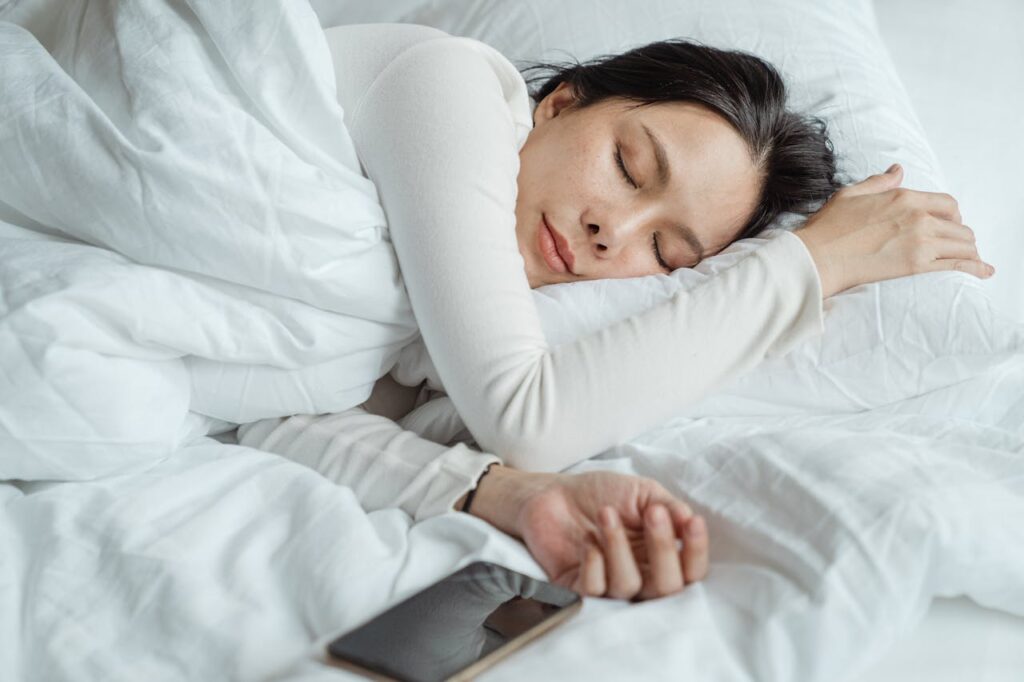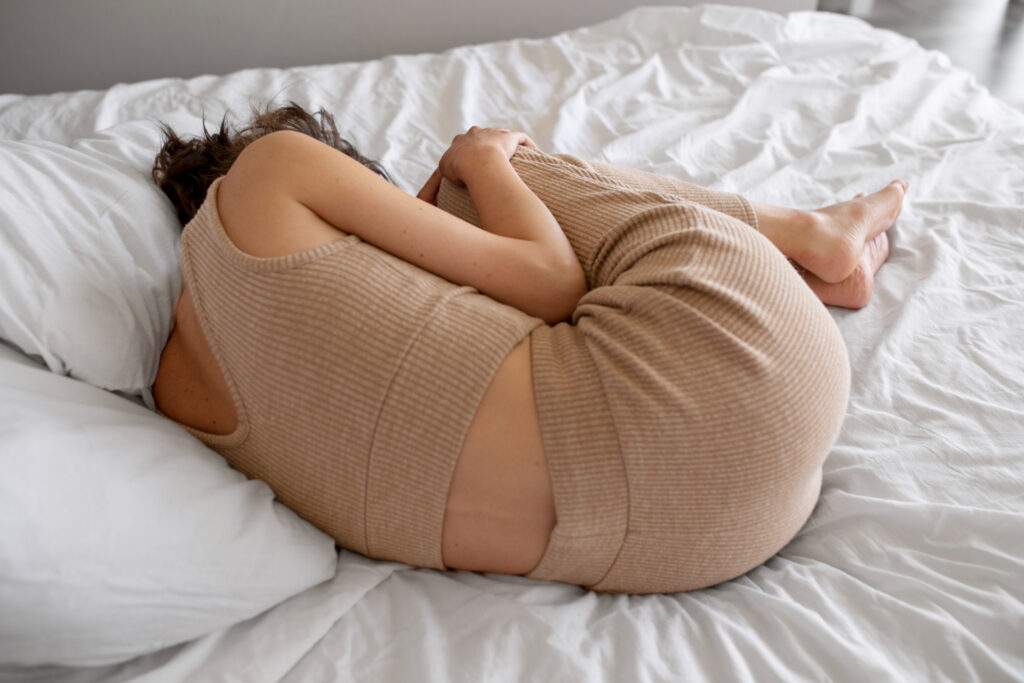Finding the optimal sleep position for back pain is crucial for anyone seeking pain-free rest and improved overall well-being. Many people underestimate the profound impact that sleep positions can have on spinal health. While it’s common to focus on mattresses and pillows, the way you position your body during sleep can significantly influence back pain.
Despite its importance, the topic of sleep position for back pain relief is seldom explored in depth. Most advice skims the surface, suggesting general recommendations without delving into the unique needs of those suffering from specific types of back pain. Our goal in this article is to provide a comprehensive, evidence-based guide tailored to those who experience back pain, helping them discover the best ways to sleep pain-free.
Understanding the connection between sleep positions and back pain involves looking at how different positions affect spinal alignment and muscle tension. We’ll explore common sleep positions, such as back, side, stomach, and fetal positions, and analyze their respective benefits and drawbacks. By doing so, we aim to offer personalized insights that go beyond conventional wisdom, addressing the specific concerns of our health-conscious audience.
Whether you’re dealing with chronic lower back pain or occasional upper back discomfort, knowing the optimal sleep position can make a significant difference in your quality of life. This article is dedicated to helping you find that perfect position, ensuring restful nights and pain-free mornings.
Table of Contents
1: Understanding the Connection Between Sleep Positions and Back Pain

1.1 The Importance of Sleep Position
The optimal sleep position for back pain is not just about comfort; it’s crucial for maintaining proper spinal alignment. When you sleep in a position that supports the natural curve of your spine, you reduce the strain on your back muscles and ligaments. This can alleviate existing back pain and prevent new issues from developing. While it’s tempting to overlook sleep position in favor of focusing on mattresses and pillows, the way you position your body during sleep plays a pivotal role in spinal health.
1.2 How Poor Sleep Positions Can Cause Back Pain
Poor sleep positions can exacerbate or even cause back pain by placing undue stress on the spine. For example, sleeping on your stomach forces your neck to twist and your lower back to arch excessively, leading to discomfort and pain. Similarly, sleeping in a fetal position can strain the back if not done correctly. Each position has specific impacts on different areas of the spine, and understanding these can help in choosing the right position to mitigate pain.
1.3 Factors Affecting Sleep Position Choice
Choosing the optimal sleep position for back pain relief involves considering several factors:
- Individual Anatomy: Body shape and weight distribution can influence which sleep position provides the best support.
- Existing Medical Conditions: Conditions like sleep apnea, acid reflux, and chronic pain can dictate the most beneficial sleep position.
- Personal Comfort: Ultimately, the best position is one that allows for a restful and uninterrupted night’s sleep.
For a detailed exploration of how different sleep positions affect overall health, including back pain, refer to this article by Dr. Philip L. Pirtle, a pulmonologist and sleep medicine specialist here. Dr. Pirtle discusses the benefits and drawbacks of various sleep positions and emphasizes the importance of a restful and organized sleep schedule.
By understanding the intricate relationship between sleep positions and back pain, you can make informed decisions that promote better sleep and improved spinal health. The following sections will delve deeper into the analysis of common sleep positions and expert recommendations to help you find the optimal sleep position for back pain.
2: Analysis of Common Sleep Positions
2.1 Back Sleeping

Back sleeping is often touted as the optimal sleep position for back pain because it promotes natural spinal alignment. When you sleep on your back, your weight is evenly distributed across the widest part of your body, reducing pressure points. Placing a pillow under your knees can further alleviate lower back pain by supporting the natural curve of your spine. However, back sleeping can exacerbate issues like sleep apnea and snoring, making it less ideal for some individuals.
2.2 Side Sleeping

Side sleeping is the most common position and is generally recommended for those with back pain, especially if you place a pillow between your knees. This position helps keep the spine neutral and can reduce strain on the lower back. It’s particularly beneficial for individuals with sleep apnea or acid reflux. However, consistently sleeping on one side can lead to imbalances and even shoulder pain. Alternating sides or using supportive pillows can mitigate these issues.
2.3 Stomach Sleeping

Stomach sleeping is generally discouraged for those with back pain because it forces the neck into a rotated position and creates an unnatural arch in the lower back. This position can strain the spine and exacerbate existing back problems. However, for individuals who find it hard to sleep in other positions, using a thin pillow or no pillow at all can help minimize neck strain.
2.4 Fetal Position

Sleeping in the fetal position, with knees drawn up towards the chest, can open up the space between vertebrae and alleviate lower back pain. However, curling up too tightly can restrict breathing and potentially cause stiffness. A more relaxed fetal position, with a pillow between the knees, can offer a good balance of comfort and spinal support.
By understanding the nuances of each sleep position, you can make informed choices to find the optimal sleep position for back pain relief. The next section will offer expert recommendations tailored to specific types of back pain.
3: Expert Recommendations on Optimal Sleep Position for Back Pain
3.1 Best Sleep Position for Lower Back Pain
For those suffering from lower back pain, the optimal sleep position often involves lying on your back with a pillow under your knees. This position maintains the natural curve of the spine and evenly distributes weight, reducing pressure on the lower back. If back sleeping isn’t comfortable, side sleeping with a pillow between the knees can also provide significant relief by keeping the spine aligned.
3.2 Best Sleep Position for Upper Back Pain
Upper back pain can benefit from side sleeping with a supportive pillow that keeps the head and neck aligned with the spine. Additionally, placing a pillow under the arm can alleviate shoulder strain, providing a more comfortable sleep position. Back sleeping with a small rolled towel placed under the neck and a pillow under the knees can also help relieve upper back pain by promoting proper spinal alignment.
3.3 Tips for Transitioning to a Healthier Sleep Position

Transitioning to a healthier sleep position can be challenging, but it’s essential for long-term back pain relief. Here are some expert tips to make the transition smoother:
- Gradual Adjustment: Start by spending a few minutes each night in the new position before sleeping, gradually increasing the time.
- Pillow Support: Use pillows to support your body and maintain the desired position. For example, a pillow between the knees for side sleepers or under the knees for back sleepers.
- Consistent Practice: Consistently practice the new position to help your body adapt. It might take a few weeks for it to become natural.
- Comfortable Bedding: Invest in a mattress and pillows that support your new sleep position. Memory foam or latex mattresses can provide the necessary support.
- Mindful Relaxation: Practice relaxation techniques before bed, such as deep breathing or gentle stretches, to help your body settle into the new position.
By following these expert recommendations, you can find the optimal sleep position for back pain relief, tailored to your specific needs. Remember, the key is consistency and patience. Adjusting your sleep position can significantly improve your quality of life by reducing pain and enhancing your overall well-being.
Conclusion
Understanding the optimal sleep position for back pain is essential for improving sleep quality and overall well-being. Throughout this article, we’ve explored how different sleep positions impact back pain and provided expert recommendations to help you find the most beneficial sleep posture.
Choosing the right sleep position can significantly reduce discomfort and enhance your quality of life. However, as Dr. Philip L. Pirtle, a pulmonologist and sleep medicine specialist, emphasizes, “maintaining a restful and organized sleep schedule is more important than the sleep position itself, unless one experiences overt symptoms such as sleep disordered breathing or gastroesophageal reflux”【source】. This insight highlights the broader context of sleep health beyond just positioning.

Summary of Key Points
- Importance of Sleep Position: Proper sleep positions maintain spinal alignment and reduce strain on back muscles and ligaments.
- Impact of Poor Sleep Positions: Positions like stomach sleeping can exacerbate back pain by misaligning the spine.
- Factors Influencing Sleep Position: Personal anatomy, existing medical conditions, and comfort all play a role in determining the best sleep position.
- Analysis of Common Positions: Back sleeping supports spinal alignment; side sleeping reduces strain on the spine; stomach sleeping generally causes more harm than good; and the fetal position can relieve lower back pain when done correctly.
- Expert Recommendations: For lower back pain, back sleeping with knee support or side sleeping with a pillow between the knees is ideal. For upper back pain, side sleeping with neck and shoulder support or back sleeping with neck support is beneficial. Transitioning to these positions should be done gradually with the help of supportive pillows and comfortable bedding.
By implementing these insights, you can make informed decisions about your sleep posture, leading to pain-free and restful nights. Prioritizing sleep health is a journey that involves not just choosing the right position but also ensuring a consistent and restful sleep routine. This holistic approach will ultimately contribute to better spinal health and overall well-being.





